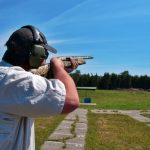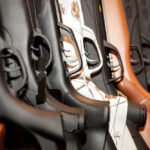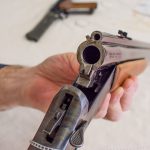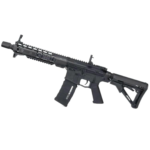The Offence of Unauthorised Possession or Use of a Pistol or Prohibited Firearm in New South Wales
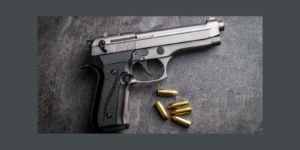
A man has been charged with firearms, robbery and intimidation offences after allegedly wielding a firearm at a popular Sydney restaurant.
It is alleged that 42-year old Viacheslav Zhadushkin pulled out a firearm and threatened staff and patrons after being handed the bill for his meal at Omnia restaurant in Brighton-Le-Sands.
According to one of the patrons, Mr Zhadushkin “was shouting and yelling at the waiters”.
The patron alleges that Zhadushkin “pointed the gun at me, and he was threatening me and my family, as he did to other waiters and staff.”
“We were all shocked … terrified and panicked”.
Police say they located a replica Colt firearm on Zhadushkin, before arresting and conveying him to the police station where he was charged with seven offences, including robbery while armed with a dangerous weapon, unauthorised use or possession of a firearm and two counts of intimidation intending to cause fear or physical harm.
He was refused bail and has been remanded in custody.
Unauthorised possession or use of a pistol or prohibited firearm in New South Wales
Unauthorised possession or use of a pistol or prohibited firearm is an offence under section 7 of the Firearms Act 1996 which carries a maximum penalty of 14 years in prison.
To establish the offence, the prosecution must prove beyond reasonable doubt that:
- You possessed or used a pistol or prohibited firearm, and
- You were not authorised to do so by a permit or licence.
Section 4 of the Act provides that you are in ‘possession’ if:
- You have custody of the item,
- You have it in the custody of another person,
- It is in or on any premises, place, vehicle, vessel or aircraft, whether or not belonging to or occupied by you.
Section 4A makes clear that possession encompasses where the item is in or on any premises you own, lease or occupy, or in your care, control or management, unless you satisfy the court that:
- It was placed in or on, or brought into or on to, the premises by or on behalf of a person who was authorised to do so,
- You did not know and could not reasonably be expected to have known the item was on the premises, or
- There is evidence you were not in possession of the firearm.
‘Premises’ means any place, vehicle, vessel or aircraft.
Again, a ‘firearm’ is defined as:
A gun, or other weapon, that is or was, capable of propelling a projectile by means of an explosive, and includes a blank fire firearm, or an air gun, but does not include a paintball marker.
A ‘pistol’ is a firearm that:
- is reasonably capable of being raised and fired by one hand, and
- does not exceed the dimensions prescribed by the regulations.
Schedule 1 of the Act contains a long list of ‘prohibit firearms’ which include:
- Machine guns, sub-machine guns and other automatic weapons capable of shooting bullets in rapid succession,
- Self-loading shotguns, rim-fire and centre fire rifles,
- Firearms capable of discharging liquid, powder, gas, chemicals, flares or dye
- Canons and powerheads, and
- Firearms disguised as other items, such as walking sticks.
Section 4D makes clear that it includes an ‘imitation firearm’ which is an object that, regardless of its colour, weight or composition, or the presence or absence of any moveable parts, substantially duplicates in appearance a firearm, but is not a firearm.
It does not include an object produced and identified as a children’s toy.
Unauthorised possession or use of a firearm in New South Wales
Unauthorised possession or use of a firearm is an offence under section 7A of the Firearms Act 1996 which carries a maximum penalty of 5 years in prison.
To establish the offence, the prosecution must prove beyond reasonable doubt that:
- You possessed or used a firearm, and
- You were not authorised to do so by a permit or licence
The definition includes gel blasters and BB guns, but again does not include object produced and identified as children’s toys.
The offence of armed robbery in New South Wales
Armed robbery is an offence under section 97 of the Crimes Act 1900 which carries a maximum penalty of 20 years in prison
To establish the offence, the prosecution must prove beyond reasonable doubt that you:
- Were armed with an offensive weapon or instrument, or were in the company of another person or persons, and
- Robbed or assaulted another person with the intention to rob, or stopped any mail, person with mail, vehicle, train with the intention to rob or search.
The legislation does not define the word ‘rob’. However, the courts have found that it is where:
“the victim… [is] compelled by force or fear to submit to the theft”… It is not necessary that the offender applies force… It is enough that the offender by his or her conduct…Puts the victim in fear of violence”.
‘Offensive weapon or instrument’ means:
- A dangerous weapon, or
- Anything made or adapted for offensive purposes, whether or not it is ordinarily used as a weapon or capable of causing harm
The maximum penalty increases to 25 years in prison where you were armed with a ‘dangerous weapon’ which is:
- A firearm or imitation firearm,
- A prohibited weapon, or
- A spear gun.
The offence of stalking or intimidation in New South Wales
Section 13 of the Crimes (Domestic and Personal Violence) Act 2007 prescribes a maximum penalty of 5 years in prison and/or a fine of $5,500 for any person who stalks or intimidates another person with the intention of causing the other person to fear physical or mental harm.
For the purposes of the section:
- causing a person to fear physical or mental harm includes causing the person to fear physical or mental harm to another person with whom he or she has a domestic relationship,
- a person intends to cause fear of physical or mental harm if he or she knows that the conduct is likely to cause fear in the other person,
- the prosecution is not required to prove that the person alleged to have been stalked or intimidated actually feared physical or mental harm, and
- an attempt to commit the offence is enough to establish the offence.
‘Intimidation’ is defined by section 7 of the Act as:
- conduct (including cyberbullying) amounting to harassment or molestation of the person,
- an approach made to the person by any means (including by telephone, telephone text messaging, e-mailing and other technologically assisted means) that causes the person to fear for his or her safety, or
- any conduct that causes a reasonable apprehension of injury to a person or to a person with whom he or she has a domestic relationship, or of violence or damage to any person or property.
The court may have regard to any pattern of violence (especially violence constituting a domestic violence offence) in the person’s behaviour when determining whether conduct amounts to intimidation.
Defences to the charges
For each of the above charges, the defences of self-defence, duress and necessity may apply.
In the event that the defendant raises evidence of any such defence, the prosecution must then disprove the defence beyond a reasonable doubt.
Australia’s tough gun control laws
Australia has some of the toughest gun laws in the world, introduced during the Howard Government after the Port Arthur massacre in 1996 that cost 35 Australian their lives and wounded 23 others.
Under the new laws that were created, semi-automatic rifles and shotguns were prohibited, with a few exceptions, it became mandatory to register all firearms, and to provide proof of reason for all gun-licence applicants and gun purchases, with self-defence not considered a reason. Ammunition sales were restricted.
There was also a buy back of semi-automatic weapons and guns from owners no longer qualified to possess them and an amnesty which required others in possession of guns without need, to hand them over.
At the time, hundreds of thousands of guns were destroyed. Since then, there have been other, similar gun amnesties. Since the Port Arthur massacre, the number of licensed gun owners has declined by about a third across Australia, even despite a much larger population base. Consistently Australian gun laws are held up globally as the standard to aspire to.
Since Port Arthur there have been a number of cases that have brought gun laws back into the spotlight, with some believing that there are still failings that need to be addressed.
Calls for further gun law reform
In 2019, Benjamin Glenn Hoffmann was charged with shooting several men in Darwin.
Last year, mid-way through his trial, Mr Hoffman pleaded guilty to eight charges, including three of murder and one of manslaughter, as well as recklessly endangering life and making a threat to kill. At the time various experts pointed out the rise in guns available on the black market and also the potential problem of existing owners “stockpiling” weapons, which could then be stolen.
In 2018, Sydney teenagers Jack and Jennifer Edwards were shot dead by their estranged father John Edwards. The children’s mother, John’s former wife, committed suicide weeks later.
The subsequent coronial inquest made significant recommendations for further gun reform including: more training for firearm registry staff to recognise risks of domestic violence, and increased information sharing between the firearms registry, police and the family court.
Going to court?
If you have been accused of a firearms offence and are going to court, call Sydney Criminal Lawyers anytime on (02) 9261 8881 for strong representation by an experienced criminal defence team who will explain your options, the best way forward and fight for the optimal outcome in your case.
Receive all of our articles weekly
Related Articles
RELATED LEGISLATION
- Section 7 Firearms Act 1996 | Offence of Unauthorised Possession or Use of Pistols or Prohibited Firearms
- Section 7A Firearms Act 1996 | Offence of Unauthorised Possession or Use of Firearms Generally
- Section 97 Crimes Act 1900 | Robbery While Armed or In Company
- Section 13 Crimes (Domestic and Personal Violence) Act 2007 | The Offence of Stalking or Intimidation




